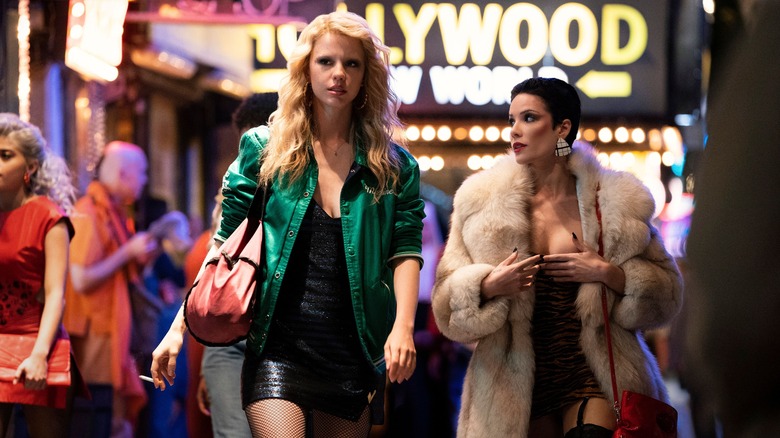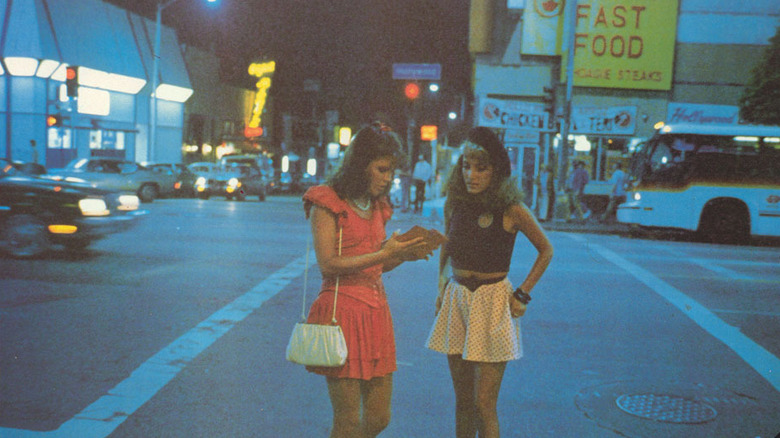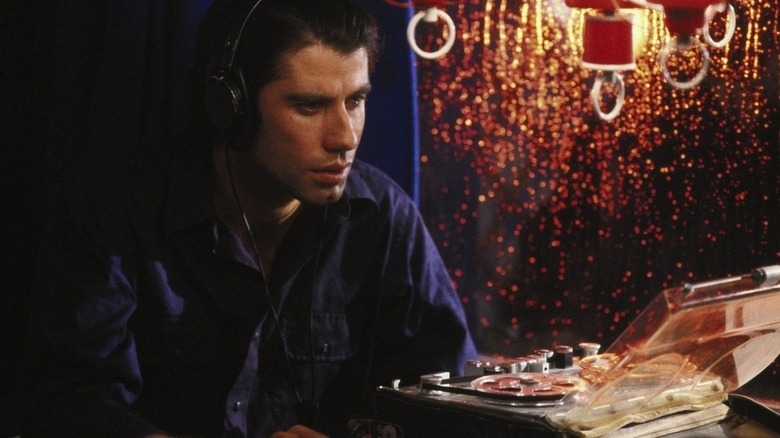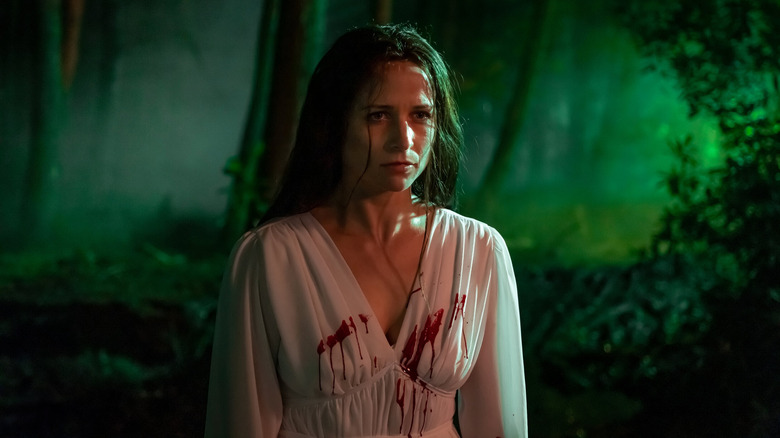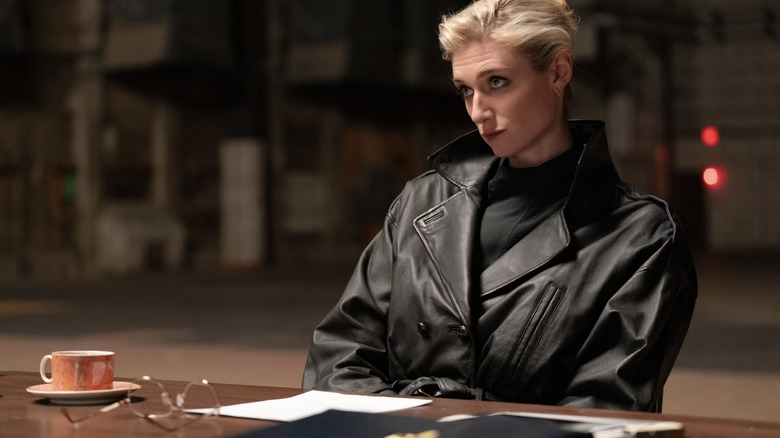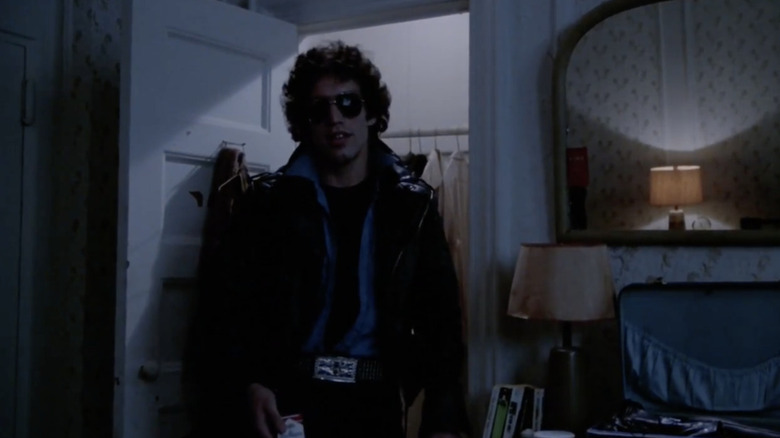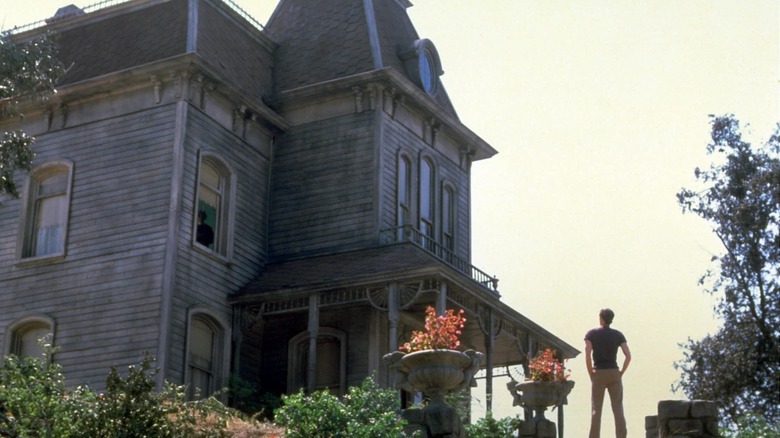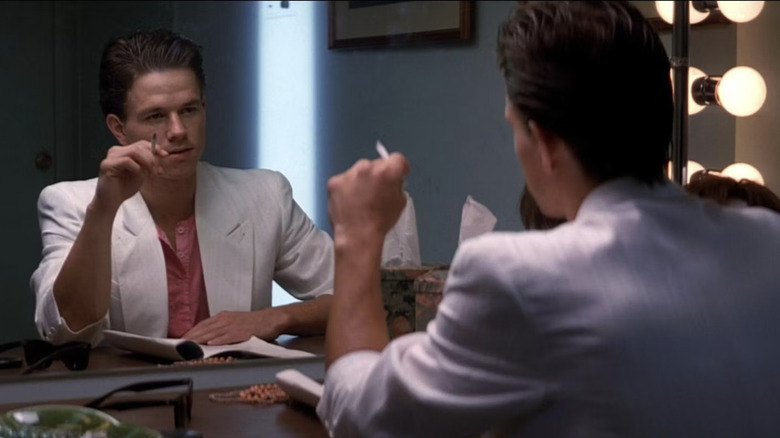Every Horror Movie Reference In Ti West's MaXXXine
This article contains spoilers for "MaXXXine."
Writer/director Ti West trilogy of films starring Mia Goth — "X," "Pearl," and now "MaXXXine" — are, first and foremost, a solid trio of character-based horror films. Taken at face value, they tell an eerie, sexy, and violent cautionary tale about two women, Pearl and Maxine (both played by Goth), whose ambitions for stardom lead them to commit sinful acts.
Taken metaphorically, however, the films have a ton to say about the history of cinema itself, with a particular focus on the tense relationship between prurience and art that's existed within the medium since its inception. Horror movies and pornographic films have long been associated with each other, and West draws on that connection to explore the effects cinema has on everything from standards of youth and beauty — particularly when it comes to women — as well as the American Dream of going from rags to riches.
While the trilogy doesn't necessarily omit influences from international cinema, it's clear that West is largely focused on American films as the best reflection of these themes. Where the first two movies took place in rural Texas, MaXXXine is set in "Tinseltown, California" in 1985, creating opportunities for a plethora of horror film references. What follows is an attempt to make a nearly-comprehensive list of every horror movie Easter egg in "MaXXXine." So grab your severed head, try not to scream, and keep repeating to yourself: it's only a movie ... it's only a movie...
LA Sleaze movies and MaXXXine
The 1985 Los Angeles of "MaXXXine" is not the same '80s California as the one seen in "E.T." or "The Karate Kid." Given how Maxine Minx (Goth) finds herself shooting a horror movie while attempting to evade the attentions of a mysterious, vicious serial killer, "MaXXXine" belongs to the proudly disreputable tradition of LA Sleaze.
The West Coast sister to NYC Sleaze, two of LA Sleaze's finest are Gary Sherman's "Vice Squad" from 1982 (which West has name-dropped as one of his influences for "MaXXXine"), and 1984's "Angel," directed by Robert Vincent O'Neil. Both of those films, like "MaXXXine," focus on the street- and night-life of Hollywood, a twilight world where sex workers, cops, and other hunters and prey are stalked by deviant maniacs. A little later in the decade, Katt Shea's "Stripped to Kill" continued this tradition with aplomb, and, like "MaXXXine," explored the dynamic between female sexual liberation and making oneself an unwitting target.
Adding some exploitation-style reality to the mix, "MaXXXine" uses a real-life serial killer of the period, Richard Ramirez aka The Night Stalker, as a red herring for its own fictional killer. Although Ramirez only operated between April '84 to August '85, there were several films in the late '70s and early '80s that were shot and set in California which were heavily inspired by other real-life serial killers. These films, such as "Killer's Delight," "The Toolbox Murders" (both 1978), 1980's "Don't Answer the Phone" and 1983's "10 to Midnight" all use their true crime elements to salacious, exploitative — dare I say sleazy — ends.
MaXXXine has a dash of giallo and noir
Where "X" was generally a '70s-style slasher and "Pearl" was primarily a '50s-style riff on the "woman's picture," "MaXXXine" is a mixture of LA Sleaze, film noir and Hollywood giallo. The film's primary homage to the latter subgenre, particularly its Italian cinema origins, lies in its killer's use of black gloves. This is a nod to the giallo films of Dario Argento, who established his oft-used black gloved killer trope in his first film, "The Bird With the Crystal Plumage." While there's a bit of international horror flair to "MaXXXine" (particularly in its kill sequences and in a viewing booth scene that recalls the British thriller "Don't Open Till Christmas"), it mostly pays homage to the domestic Hollywood brand of giallo: films like "Eyes of Laura Mars," "Jack's Back," and the Hitchcock-infused works of Brian De Palma, most notably 1984's "Body Double."
The brand of film noir that "MaXXXine" belongs to is primarily the neo-noir strain that kicked off in a big way during the '80s with films like "Mike's Murder" and "Blow Out" (the latter being another De Palma). The seedy PI hired to stalk Maxine by the killer, John Labat, is not only played by a veteran of '80s slashers (Kevin Bacon of "Friday the 13th"), but is also akin to other sleazy PI characters from films like "The Big Easy" and "Blood Simple." Labat also acts as part of the way "MaXXXine" culminates the "X" trilogy's riff on Hitchcock's "Psycho" — more on that film in a moment.
The dark side of Hollywood
One of the major themes of the "X" trilogy is the way Hollywood and the films it produces play a role in influencing (and/or changing) people's ethics and values. "MaXXXine" continues this theme in a big way, particularly regarding the movie being made by the killer stalking Maxine, who turns out to be none other than her own fundamentalist preacher father, Ernest (Simon Prast). Ernest is filming each killing as fodder for his exposé movie about the sins of Hollywood, and this film-within-a-film feels highly akin to the works of Baptist minister and filmmaker Estus Pirkle, whose 1974 movie "The Burning Hell" is a similar type of shock-them-into-faith feature.
"MaXXXine" also belongs to a string of films that take a harsh look at the effects of Tinseltown on the unstable psyche. This was explored in movies such as 1973's "Hollywood 90028" and 1983's "Variety," both films blending themes of sexual awakening and film noir that have a darkly satirical edge. In contrast to movies about the rampant issues behind the camera in the film industry, "MaXXXine" is more concerned with potentially adverse effects of the movies themselves and the culture they promote — the better to contrast with Ernest's sanctimonious crimes in the name of so-called purity. Though a more recent film, Prano Bailey-Bond's "Censor" from 2021 (pictured above) tackles this dynamic head-on, taking a look at the hypocrisy within the UK's campaign against the movies their media dubbed "video nasties," which were by and large horror films.
What 'The Puritan II' represents in MaXXXine
Speaking of video nasties, it seems that Maxine finds herself involved in making one when she's cast in "The Puritan II," a horror sequel directed by Elizabeth Bender (Elizabeth Debicki). Some aspects of "The Puritan II" are fairly obvious: the way the fictional film-within-a-film comments on both Ernest's outwardly pious and secretly monstrous film-within-a-film, as well as the theme of the resurgent Satanic Panic and protestation of horror films that was occurring during the decade. The fictional movie also represents religious-themed horror movies, both well-known classics like "The Exorcist" and "The Omen" and the sleazier, low-budget offerings of the '80s such as "The Unholy." In terms of style, "The Puritan II" appears to recall the salacious, lightly surrealist efforts of Ulli Lommel, whose "The Boogey Man" had a sequel, "Boogeyman II," in which a group of Hollywood types attempt to exploit the events of the first film.
In terms of real-life female filmmakers who were making their names in Hollywood around this time via low-budget horror, like Elizabeth is, there is the aforementioned Katt Shea, Stephanie Rothman (director of "The Velvet Vampire"), Amy Jones ("The Slumber Party Massacre"), Barbara Peeters ("Humanoids From the Deep") and Kathryn Bigelow ("Near Dark"). Despite these potential inspirations, Debicki apparently and amusingly based her character on none other than ... Ti West himself! As Debicki told Collider recently, she believes that her character and West understand that "horror is an excellent Trojan horse for messaging and for performance."
Video store cruising in MaXXXine
Although there aren't many scenes set in the video store run by Maxine's pal Leon (Moses Sumney), there are a few Easter eggs that pop up there, such as when Leon rattles off names of actors who became stars after famously appearing in horror (people like Brooke Shields, John Travolta, Demi Moore, and Jamie Lee Curtis). At one point, Leon appears to be watching an alligator attack film, which recalls the alligator attack during "X" when Bobby-Lynne Parker (Brittany Snow) was gobbled up by Pearl's gator Theda, who also ate Pearl's father during the events of "Pearl."
The most notable scene in the video store is Leon's death, which comes at the hands of the black-gloved Ernest shortly after Leon is distracted by a man attempting to solicit him for a discreet liaison. The context of this scene, followed as it is by a brutal stabbing, echoes director William Friedkin's eerie thriller about male homosexual identity and gay panic, "Cruising," from 1980.
The return of Psycho (and Scream) in MaXXXine
The biggest influence on the "X" trilogy is unmistakably Alfred Hitchcock's "Psycho," the 1960 shocker all about a boy and his sort-of-dead mother. Even though film history is a spectrum, it's clear in hindsight that "Psycho" provided the blueprint for what would become the slasher film, with the movie's infamous "shower scene" kill paving the way for bravura sequences of murder in horror cinema.
As such, West made sure to have his porno filmmakers in "X" (Maxine included) discuss "Psycho" and its impact, ostensibly to make a meta reference about a movie's story changing partway through (i.e. what is essentially the narrative structure of most slasher movies, including "X") as well as subtly acknowledge the "killer old woman" trope, which "Psycho" popularized and "X" indulged in.
Following "Pearl" and her allegorical relationship to Norman Bates (having overbearing parents who she murders, etc.), "MaXXXine" makes the trilogy's connection to "Psycho" more explicit, as Elizabeth takes Maxine to visit the actual house built for shooting the Hitchcock film on the Universal Studios lot. During this scene, Elizabeth also mentions how 1983's "Psycho II" was recently shot there. This is not an incidental reference at all, for both "MaXXXine" and "Psycho II" feature protagonists who are portrayed as highly sympathetic (despite committing acts of murder) when their respective pasts come back to haunt them.
West winks at another pre-eminent meta horror franchise soon after. When Labat turns up on the lot and chases Maxine, she runs through various well-known bits of the Universal backlot in much the same way Sidney Prescott flees through a Hollywood version of her hometown in "Scream 3."
MaXXXine's non-horror references
While "MaXXXine" and the "X" trilogy is mostly focused on horror and adult entertainment, it doesn't limit itself to those genres; after all, Maxine and her friend Tabby (Halsey) walk below a marquee advertising Joel Schumacher's coming-of-age film "St. Elmo's Fire." Perhaps the most intriguing reference to a non-horror movie is final scene, in which we once again see Maxine gassing herself up in the mirror — a reference to the finale of Paul Thomas Anderson's "Boogie Nights" (a movie about the porn industry, no less). That movie was itself referencing the finale of Martin Scorsese's "Raging Bull." Like I said, cinema is one big spectrum.
While this article is by no means a complete list of all the references and allusions within "MaXXXine," it should help illuminate just how many levels this film and the "X" trilogy are working on. Ti West isn't merely making retro genre movies to celebrate his cinematic faves. He's using these movies to delve into the messy, murky history of cinema and all that it gets us devotees to sacrifice for it — whether it's something as small as our time and energy or as large as murder. "Good artists copy, great artists steal," an observation most often attributed to Pablo Picasso, certainly applies to these films, how they're able to take so many elements of the past, re-use them, comment on them and make them feel fresh and relevant all over again.
"MaXXXine" is in theaters now.
